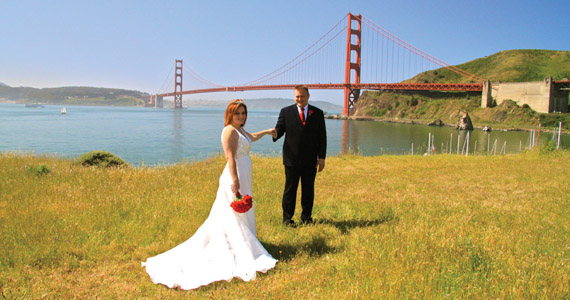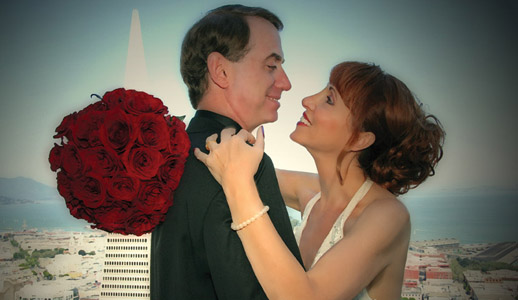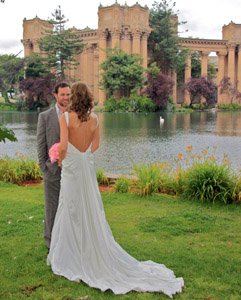Bay Area wedding planner Ema Drouillard provides environmentally conscious intendeds with a unique opportunity to start their life together on a green foot, as well as to share their passion for sustainability with friends and family members.

The average American wedding costs just under $28,000 and requires the services of 43 vendors. Minimizing the number of vendors will reduce costs, and minimize carbon emissions from vehicles used to transport equipment and Landmark locations require no decorations or set up. Photo by Ema Drouillard
By Bill Picture
Published: September, 2010
Drouillard is encouraging couples to take a less-is-more, anti-Bridezilla approach to planning their big day. That approach minimizes the wedding’s impact on the environment, and, Drouillard believes, keeps the joy and beauty of a couple’s commitment to building a life together from getting buried under the bells and whistles of a traditional “big wedding.”
“Keep it small,” she says. “That’s the key. Minimize wherever possible.”
Drouillard first got her feet wet in the wedding business in 1971, when she was ordained as a minister so that she could officiate the wedding of her brother and his then-fiancée. “He ended up not marrying her, of course. And when he finally did get married many, many years later, he didn’t even use me,” she jokes.
Friends, however, did call upon Drouillard to officiate their ceremonies. And, after receiving several glowing reviews, she decided to market her services to the public. “And wedding planning kind of evolved from there,” she says. Drouillard now offers full-service wedding planning, and has recently won a Betty Furness Award for Intense Consumer Advocacy from the Environmental Forum of Marin.
Starting at home
Drouillard’s own passion for environmentalism led her to seek small ways to green her business practices long before the green movement took shape.
“I started with small things,” she explains. “For instance, I only run errands on my way to or from an appointment so that I don’t do any unnecessary driving. I don’t spend money on printed marketing materials, and I reuse and recycle whenever and wherever possible. And, when I take pictures for clients, I only use rechargeable batteries. Even contracts are signed electronically. ”
Those efforts were all back-end ones, however. That is, they required little, if any, participation on the part of the wedding party. According to Drouillard, until very recently, most couples weren’t willing to forego less environmentally friendly traditions for the sake of having a greener wedding.
“It’s really only in the last few years that people have started incorporating their interest in the environment into more aspects of their lives,” she says. “They’re even seeking out the services of businesses that share that interest. And that segment is definitely growing.”
Those shifts in attitude and spending prompted Drouillard to better align her business practices with her at-home ones, which she describes as “aggressive.” That has meant marketing herself as a green business—her business, Ceremony Way, was certified a green business by the County of Marin a few years ago—and encouraging clients to reprioritize, putting the health of the environment before those traditions that add flair to a ceremony, but little, if anything, else.
Small changes, big results
“It all comes down to our individual footprints; and every choice we make can help reduce that,” Drouillard explains. “All those little choices add up.”
A good place to start, according to Drouillard, is with the guest list, which any married couple will tell you can quickly get out of control.
“When you have a 300-person guest list, the bride and groom become hosts,” she says. “The focus is less on celebrating the couple’s commitment to each other and more on making sure that everyone else is being taken care of. Also, I find that the guests at smaller, more intimate weddings are more present.”
Next is choosing an appropriate venue. “Try to find a venue that can host the ceremony and the reception. It’ll cut down on the driving for your guests. Also, look for a venue that has its own equipment, and that requires a minimum amount of dressing or decoration. Whatever you need for your event that the venue can’t provide in-house, will have to be rented and trucked in. Plus, decorations often can’t be reused or recycled.”
When it comes to printed invitations, the question is: “Should we or shouldn’t we?”
Printing on 100% recycled paper and using soy-based inks is the least that an environmentally responsible couple can do. For those willing to go the extra green mile, Drouillard recommends doing away with printed invitations altogether and going electronic.
“It’s one less thing that will end up in the garbage,” she says. “Actually, it’s at least five things if you count the mailing envelope, the invitation, the insert that’s usually inside, the reply card and the reply envelope. An e-vite is just as effective, and just as acceptable nowadays.”
At the wedding, Drouillard recommends flowers harvested from sustainable resources. Should a couple decide to serve a meal at the reception, Drouillard recommends serving local and organic food—or choosing a caterer that does. After the wedding, Drouillard suggests posting photos online for guests to enjoy, rather than printing copies or burning CDs.
“I just heard that the average wedding employs the services of 43 vendors,” Drouillard adds. “Can you believe that? Again, minimize. The fewer vendors you use, the greener your event is. Not only are you reducing carbon emissions from the trucks used to transport things, you also have to think about how green each vendor’s office practices and purchasing procedures are.”
Check, please
When it comes to weddings, keeping it simple (and small) is not only better for the environment. It’s also more economical, which is a big concern for couples given today’s financial climate. According to TheKnot.com, a wedding resources website, the average American wedding costs just under $28,000. Drouillard specializes in weddings for under 25 guests and offers packages starting at around $500.
Of course, keeping it small means that some distant relative, family friend or coworker isn’t going to make the cut. For those couples that would prefer to not have to deal with the headache of creating a guest list, who would prefer to have just a few very close loved ones on hand for the ceremony, or who would simply prefer to keep costs to an absolute minimum, Drouillard suggests another option—eloping.
“We call them ‘destination weddings’ now,” jokes Drouillard. “When you hear that someone is ‘eloping,’ you think of people sneaking off in the middle of the night to get married. Nowadays, it’s a viable alternative to a bigger wedding, with people planning them up to a year in advance. Sometimes it’s just the bride and groom; sometimes they invite along a few close friends and family members. These kinds of weddings represent 20 percent of the market now.”
The number of destination weddings is increasing so quickly that wedding industry conferences have begun including seminars to help wedding planners meet the demand.
“Wedding planning is just like any other business. You have to change with the times,” Drouillard says. “You have to constantly be morphing. I’m always looking to see how I can improve the process, to make it simpler for the couple, greener and more cost-efficient.”
For more information on Ema Drouillard and her green wedding packages, visit www.ceremonyway.com.

Twenty percent of couples are now choosing to elope to escape the high cost and headaches of traditional big weddings. The wedding industry has renamed these intimate affairs “destination weddings.” Photo by Ema Drouillard

Green wedding planners say it keeps the focus on the bride and groom, who are often reduced to party hosts at large weddings. Photo by Ema Drouillard

